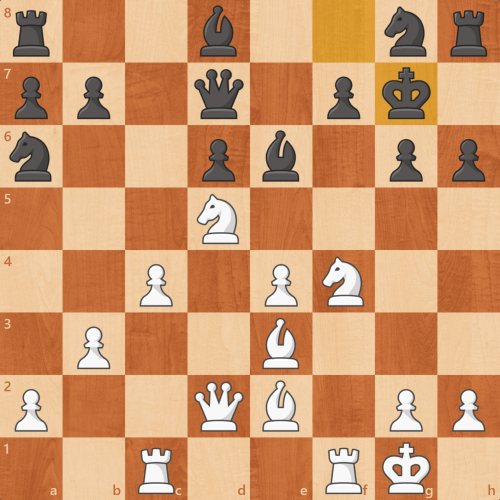I played an entertaining game against MadChess a few evenings ago. Prior to the game, I adjusted MadChess’ strength reduction parameters because I felt their values caused the engine to play too strongly for a given Elo rating. Perhaps my adjustments made the engine too weak. I’m using “feel”, a very unscientific process. Nevertheless, I enjoyed the game.
I played white. MadChess played black, set to 900 Elo. Time control is blitz, 5m + 5s. The game began 1.e4 c5 2.Nf3 g6 3.d4 d6 4.dxc5 Qa5+ 5.Nc3 Qxc5 6.Nd5 Qc6.
Here I missed a tactic. Can you spot it?
I didn’t see it. The tactic is available on this move and my next three moves because MadChess didn’t “see” the tactic either. See Search Speed for an explanation of how MadChess’ strength reduction algorithm affects the engine’s “sight”.
The game continued 7.Be2 e5 8.O-O h6 9.Be3 Be7 10.c4 Kf8 11.b3 Be6 12.Rc1 Na6 13.Qd2 Qc8 14.Ne1 Bd8 15.Nd3 Qd7 16.f4 exf4 17.N3xf4 Kg7

r2b2nr/pp1q1pk1/n2pb1pp/3N4/2P1PN2/1P2B3/P2QB1PP/2R2RK1 w - - 1 18
Let’s light this fuse. Bd4+!
Material is even, but clearly I’m winning. However, winning “won” games at blitz time control is not guaranteed at my patzer skill level. There’s always a chance I blunder material back to my opponent. Or run out of time. Pushing those concerns aside, I pressed my advantage, didn’t make any egregious errors, and managed my time well.
After I won the game, I gave Komodo Dragon two seconds per position to analyze the game. I then played through the game with Komodo Dragon and MadChess running at full strength, each displaying four best moves (MultiPV = 4). I explored a few variations where I didn’t understand why a particular move didn’t work, consulted the engines, and added refutation lines and comments to the game.

 I work as a Software Architect at an insurance company. We're building a modern tech stack in the cloud using C#, Azure, ASP.NET Core, Angular, TypeScript, etc.
I work as a Software Architect at an insurance company. We're building a modern tech stack in the cloud using C#, Azure, ASP.NET Core, Angular, TypeScript, etc.